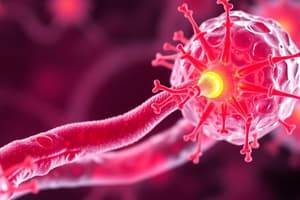Podcast
Questions and Answers
What distinguishes eukaryotic cells from prokaryotic cells?
What distinguishes eukaryotic cells from prokaryotic cells?
Eukaryotic cells have a well-defined nucleus and membrane-covered organelles, while prokaryotic cells lack a defined nuclear membrane and membrane-bound organelles.
Why are viruses not considered cells?
Why are viruses not considered cells?
Viruses are not considered cells because they are not composed of cells and cannot survive or reproduce without a host.
What are two key features that all cells share?
What are two key features that all cells share?
All cells grow and reproduce, and they use energy.
How do prokaryotic cells replicate their genetic material?
How do prokaryotic cells replicate their genetic material?
What is the smallest living unit of an organism?
What is the smallest living unit of an organism?
What are two organelles that are unique to plant cells?
What are two organelles that are unique to plant cells?
Describe the function of the mitochondria in both plant and animal cells.
Describe the function of the mitochondria in both plant and animal cells.
What role does the nucleus play within the cell?
What role does the nucleus play within the cell?
What is the function of ribosomes in cells?
What is the function of ribosomes in cells?
Explain the function of the cell membrane.
Explain the function of the cell membrane.
Flashcards are hidden until you start studying
Study Notes
Introduction to Cells
- Cells are the fundamental units of life, serving as the structural and functional components of all living organisms.
- All living organisms are composed of cells, which arise from pre-existing cells, except for viruses, which lack cell structure and depend on hosts for survival.
- Cells are the smallest living units, often invisible to the naked eye. They are capable of growth, reproduction, energy utilization, adaptation, and environmental response.
- Organisms can be unicellular (single-celled) or multicellular (composed of many cells).
Types of Cells
- Two primary categories of cells exist: Eukaryotes and Prokaryotes, both sharing common features.
- Eukaryotes include plants, animals, and fungi, characterized by a well-defined nucleus and organized organelles.
- Prokaryotes, such as bacteria, lack a defined membrane-covered nucleus and many organelles, typically having circular DNA.
Prokaryotic vs Eukaryotic Cells
-
Prokaryotic Cells:
- Absence of a membrane-covered nucleus.
- No membrane-bound organelles.
- Circular DNA structure, typically found in bacteria.
-
Eukaryotic Cells:
- Presence of a well-defined nucleus.
- Contain membrane-covered organelles.
- Linear DNA structure, found in animal and plant cells.
Eukaryotic Cell Types
- Eukaryotic cells are divided into two main types: Animal Cells and Plant Cells.
Differences Between Animal and Plant Cells
-
Common Organelles:
- Nucleus, Golgi Complex, Mitochondria, Lysosomes, Endoplasmic Reticulum, Ribosomes, and Cell Membrane present in both cell types.
-
Unique Organelles in Plant Cells:
- Chloroplasts for photosynthesis.
- Cell wall for structural support.
- Larger vacuoles for storage.
Core Organelles
-
Cell Membrane:
- Outer barrier of the cell, regulating nutrient intake and waste expulsion.
-
Cytoplasm:
- Jelly-like fluid that holds organelles in place.
-
Nucleus:
- Control center containing the cell's DNA, overseeing cell operations.
-
Mitochondria:
- Powerhouse of the cell, generating energy for cellular functions.
-
Ribosomes:
- Sites for protein synthesis, crucial for cell function and growth.
Studying That Suits You
Use AI to generate personalized quizzes and flashcards to suit your learning preferences.




